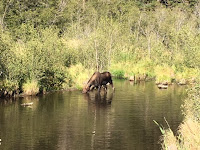I have been dying leather using water based dyes and have experimented with mixing the colors to create unique leather book covers.
One day I saw a video on using using Rit all-purpose powder dye to tie-dye teeshirts (https://www.ritdye.com/techniques/ice-dye/). Rit dye has long been used to dye leather shoes and purses, so I decided to try the ice technique to dye some leather book covers.
Besides the dye and ice you need a large container, something to support the leather above the bottom of the container and gloves to keep your hands from being stained too.
The vegetable tanned leather is cut to the desired book cover size. The cut leather is placed on top a white expandable storage shelf that is inside a large plastic container. Using this setup I can dye two large book covers at a time.
Crushed ice is piled on top of the leather, covering all of the surface to about 1.5 inches deep. Various colors of Rite dye are sprinkled on top of the ice. I do this outside, so depending on the temperature, it takes 1 to 3 hours for the ice to totally melt.
As the ice melts the dye dissolves and runs down on to the leather. The colors mix making puddles of colors that, as more ice melt, drip of the edge of the leather into the plastic container. This process creates unpredictable swirls of mixtures of colors. I let the leather sit over night to dry.
Once the leather is dry I can add freehand ink drawings or stamps to the surface. The final step is to apply a sealant to the leather. Below are three finished books. I found a multi-colored skull button that is the perfect finishing touch.









































